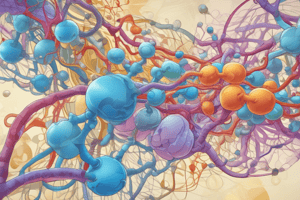Podcast
Questions and Answers
What is the primary aim of the process described?
What is the primary aim of the process described?
- To change the chemical composition of the homogenate
- To separate cellular organelles and macromolecules based on molecular weight (correct)
- To enhance the activity of biological macromolecules
- To increase the size of cellular organelles
Which technique is utilized to isolate particles that are similar in size but different in density?
Which technique is utilized to isolate particles that are similar in size but different in density?
- Electrophoresis
- Filtration method
- Density gradient ultracentrifugation (correct)
- Differential centrifugation
What is commonly used to create a density gradient in ultracentrifugation?
What is commonly used to create a density gradient in ultracentrifugation?
- Gelatin
- Water
- Sucrose (correct)
- Ethanol
After centrifugation in density gradient ultracentrifugation, what happens to the cellular constituents?
After centrifugation in density gradient ultracentrifugation, what happens to the cellular constituents?
Why would ultrasounds be used during the purification of nucleoli?
Why would ultrasounds be used during the purification of nucleoli?
What is the initial step required for the separation of cellular constituents?
What is the initial step required for the separation of cellular constituents?
Which method is NOT mentioned as a way to achieve homogenization?
Which method is NOT mentioned as a way to achieve homogenization?
What factors affect the sedimentation of particles during centrifugation?
What factors affect the sedimentation of particles during centrifugation?
What is the purpose of using lysozyme in homogenization?
What is the purpose of using lysozyme in homogenization?
What is the maximum speed of rotation for ultracentrifuges?
What is the maximum speed of rotation for ultracentrifuges?
Which type of centrifuge is primarily used to fractionate plasma from blood elements?
Which type of centrifuge is primarily used to fractionate plasma from blood elements?
What is differential ultracentrifugation (DUC)?
What is differential ultracentrifugation (DUC)?
Which of the following is an appropriate treatment for homogenization of animal tissues?
Which of the following is an appropriate treatment for homogenization of animal tissues?
Flashcards are hidden until you start studying
Study Notes
Cell Fractionation: Homogenization and Separation
- Cell fractionation is a technique used to separate cellular components for biochemical and structural analysis.
- Homogenization disrupts cells to release organelles and molecules, creating a cellular homogenate.
- Homogenization methods:
- Physical: Ultrasound or hypotonic solutions
- Chemical: Detergents
- Mechanical: Grinding and crushing
- Enzymatic digestion can enhance homogenization for specific cell types:
- Lysozyme: Degrades bacterial walls
- Trypsin: Degrades animal tissue extracellular matrix
- Cellulase: Degrades plant cellulosic walls
Ultracentrifugation: Principles and Techniques
- Centrifugation separates particles based on size and density under high gravity.
- Differential centrifugation: A series of centrifugations at increasing speeds, separating organelles and macromolecules based on their size and density.
- Produces a series of pellets and supernatants with different compositions.
- **Density gradient ultracentrifugation (DGUC): ** Separates particles of similar sizes but different densities.
- Utilizes a density gradient (e.g., sucrose gradient) to separate components based on their buoyant density.
- Factors affecting centrifugation:
- Centrifuge speed (expressed as rpm/min or g)
- Particle mass
- Density difference between particle and solvent
- Centrifugation duration
Figure 1: Cell Fractionation by Differential Ultracentrifugation (DUC)
- This figure illustrates the step-wise separation of cellular components by DUC.
- It highlights how increasing centrifugation speeds result in the precipitation of specific organelles in pellets, while the supernatant contains the less dense fractions.
- This sequential process leads to the isolation of different organelles, starting with nuclei, followed by mitochondria, lysosomes, microsomes, and finally ribosomes.
Figure 2: Cell Fractionation by Density Gradient Ultracentrifugation (DGUC)
- This figure shows how a density gradient is used to separate particles of similar size but different densities.
- After centrifugation, the particles migrate to a position in the gradient where their density matches the surrounding medium.
- This allows for the isolation of specific organelles that might be difficult to separate with DUC alone.
The Importance of Ultrasound in Nucleoli Purification
- Ultrasound can be used to disrupt cell membranes and release intracellular components.
- In the case of nucleoli purification, ultrasound can help to release nucleoli from the nucleoplasm, facilitating their isolation.
- Ultrasound is often used in combination with other methods, such as differential centrifugation, to achieve efficient separation of organelles.
Studying That Suits You
Use AI to generate personalized quizzes and flashcards to suit your learning preferences.



